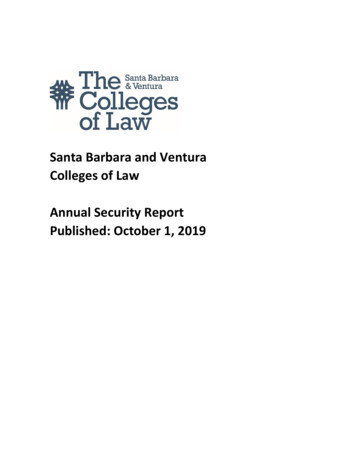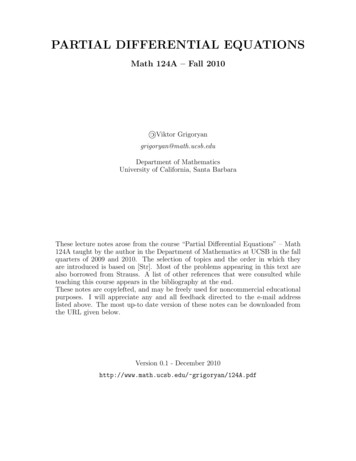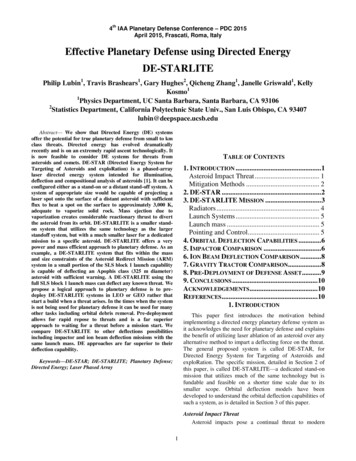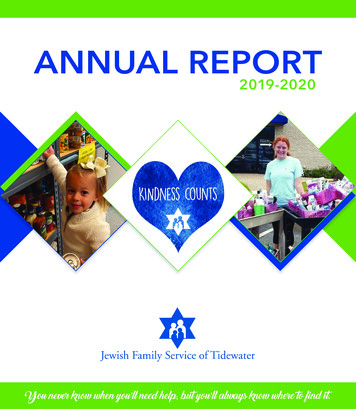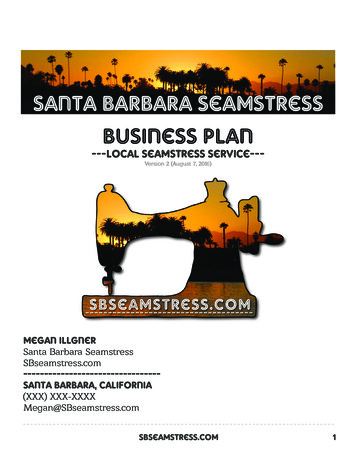
Transcription
Business Plan---Local Seamstress Service--Version 2 (August 7, 2016)Megan IllgnerSanta Barbara --------Santa Barbara, California(XXX) -------------sbseamstress.com1
Table of Contents:Executive Summary. page 3Business Description. page 4Marketing Plan. page 10Financial Plan. page 18Marketing & Operations. Page m2
Executive SummarySanta Barbara Seamstress is a business that offers general seamstress workto Santa Barbara locals. The mission is to serve local sewing needs primarilyfor, but not limited to, clothing. This business is unique in that textile design services are offered in addition to traditional seamstress work. Clientscan co-design creations with their seamstress.The business studio is located at SBCAST (Santa Barbara Center for Art, Science, & Technology) at 513 Garden St. It is owned by Megan Illgner who hasbeen sewing since childhood and has experience as a manager and graphicdesigner.Customers are people who live within a 25 mile radius of the studio whoneed sewing services. They will buy from Santa Barbara Seamstress because they require that a practical need be serviced and they appreciatethe artistic style that is revealed on the website.The competition is other seamstresses and tailors within the city who offersimilar services. They have been around longer and established themselveswith a loyal client base, but they follow the old model of simply being asewing service, and do not offer design services.Financially, it will be successful because it is astraightforward service model. Overhead costs arelow and full-time work results in guaranteed profit.Typical overhead costs are currently at about just Xper month.STATEMENT OF PURPOSEThis business plan is to serve as an operating guide for Santa BarbaraSeamstress during its first year of ress.com3
Business DescriptionSanta Barbara’s Seamstress’s mission is to serve local sewing needs primarily for, but not limited to, clothing. Based in a downtown sewing studiocalled SBCAST (Santa Barbara Center for Art, Science, & Technology) at 513Garden St. clients drop off and pick up items after scheduling appointments.The fair prices, quick service, and unexpected sparkle and flare keeps clients coming back for more. They appreciate the personality and artisticcommunity that comes with this service, which is more elaborate than theatmosphere that the local dry cleaner provides.BACKGROUNDThis business blossomed from a love of sewing, which was tailored to suitthe needs of locals. Overall, professional sewing is a dying art and in muchlower demand than 100 years ago. Today, it is rare to hire a seamstress tocustom design personal clothing. Instead, most people rely on affordableclothing retail suppliers. However, because a good seamstress has becomeincreasingly hard to find, a young, local seamstress involved in a progressiveart community can easily corner the market. There are still plenty of peoplefrom all walks of life who need something done with a sewing machine.SERVICE DESCRIPTIONSanta Barbara Seamstress (SBS) is distinguished from primary competitorsby being both a seamstress and a designer. Many competitors simply takein items and follow directions. But SBS works with clients to design freshideas and can also guide clients who lack artistic ideas. Another distinguishing factor is the culture that comes with the service. Upon viewing the website, people don’t simply peruse sewing services. Instead, they are taken ona tour of Santa Barbara through the eyes of an artist. They click on linksto local businesses. They discover the beauty of Santa Barbara because itslandmarks are the backgrounds for clothing models. They dive straight m4
to the world of music and art festivals. Even if they are not interested inthis culture themselves, they enjoy the entertaining imagery provided onthe website and see how fabrics help shape the experience. When they askfor their pants to be mended they take home a slice of the paradise festivalculture with it.TARGET MARKET & COMPETITIONThe competition is primarily other local seamstresses and tailors. There arealso department stores such as X in Paseo Nuevo shopping mall that offersuch services. However, the competition is offering to mend clothing theold fashioned way. They don’t even know that there was a new way to dothis but they are about to find out! Clients often perceive the need for clothing repair as an annoying errand that gets done between grocery shoppingand refueling at a gas station. Santa Barbara Seamstress stands out becausewhile the prices are very competitive, the experience is unexpectedly enriching. Upon discovering the business online, potential clients are dazzledby the art and culture infused with the practical images of mending. Theyhave fun looking at pictures of costumes and enjoy taking a virtual tourof SB while clicking through the site. There is even a “beyond” section onthe website which links fun websites and random entertaining videos (thishelps to reveal the personality of the business while also giving viewersanother reason to stay on the website, or to keep coming back just for entertainment’s sake).Clients also enjoy the experience of visiting the studio space at SBCAST.They need to drop off and pick up clothing for mending. Instead of stopping inside a dry cleaners or visiting a tiny isolated studio, they park in thecourtyard at SBCAST’s downtown location and walk through an art community to get to the back warehouse studio space. They take a moment to lookat the art gallery. They notice the other studio spaces and wonder what com5
is going on here. Light installations?! Video editing?! Art cars?! They interactwith other cool, local artists. They get invited by a community member toenjoy a cup of coffee on the roof with picnic tables and enjoy the fabulousview of SB. They learn about the First Thursday Art Walk event. A simple errand to drop off pants for mending is actually an invitation to enter a portalto a vibrant, local art community.Santa Barbara Seamstress is creating a unique niche through lifestyle branding. The theme of living in paradise is woven into sewing projects. Uniqueand unexpected details are added to mended garments.The ideal customer lives in Santa Barbara or surrounding areas (Carpinteria,Montecito, Goleta). They have about X- X to spend on custom designs fortheir clothing, costumes, or homes. They are conscious customers who takepride in supporting a local artist and appreciate quality work. Although theymay have many disposable, replaceable clothing items, they want to extendthe life of their most cherished garments.Packaging is also a form of art that improves the customer’s experience.They will fill out a form that details what kind of service is needed, howmany items are being dropped off, estimated wait time, and estimated pricefor service. When they pick up their item it is packaged in eco-friendly tissue paper or brown paper, accompanied by a sticker or flyer that representsthe business. It is chic and trendy.BUSINESS GOALS & STRATEGYSBS is open for business! The majority of mending work happens betweenOctober and April. From May through September, SBS is often traveling andpeddling clothing at music festivals. During the active mending months,standard hours of operation are from 10am — 4pm, Wednesday ss.com6
Sunday, but other appointments can bemade. Production occurs at a top-notchstudio with various sewing machinesthat can handle different needs. Sewingmachines include a basic domesticmachine, an industrial machine, andan industrial serger. SBS is reluctantto hire other seamstresses becausethe work is very detailed and held to ahigh standard. However, employees maybe contracted to handle social media,website maintenance, finances, andother non-sewing related tasks.SBCAST - 513 Garden StreetSewing studio at SBCASTInitially, the business will grow at therented studio space in the live-work artscommunity known as SBCAST. Whenthe time comes, it will move into its ownspace and function as a brick and mortar business. Although it will lose the advantage of being within SBCAST and itsculture, the new space will be designedto be interesting as well. Quality work,word of mouth, and stellar reputationwill keep people coming back and increase demand.This service is not really interested inmuch paid advertising. It’s the kind ofservice that people look for when theyneed it. This means that it is very om7
portant to have strong SEO for all websites and social media and is thereason that the service is named “Santa Barbara Seamstress.” That nameaddresses the who, what, and where. When people need a seamstress thewill enter a logical search online and it shows up on Facebook, Instagram,Yelp, and Google searches. The business would have to be very successful to justify a paid advertising budget and there are some very successfulcompanies that don’t really advertise (Trader Joe’s, American Girl).Other than simply being easy to find in an internet search, there is someother subtle marketing around the Santa Barbara community. A variety offlyers advertise the various services available by SBS. While maintaining asimilar brand identity full of bold, neon colors, the various flyers advertisea general seamstress service and costume design. Tabloid size flyers areprinted and hung around town (no more than X per month) and smallversions of the flyers are printed to hand out and distribute. A stack of flyers might be placed at a relevant business, such as X costume shop or X(no more than X per month). Stickers also make great promotional items.People love getting stickers and they don’t throw them away (unlike business cards) because they stick to things. They might get stuck on a waterbottle or day planner, which will remind them of the service. Stickers willbe included with each service provided by the company or handed out atrandom events just for fun (100 stickers is about X and will be reorderedas needed).OWNER EXPERIENCESanta Barbara Seamstress is a sole proprietorship owned and operated byMegan Illgner, who is in charge of all primary tasks of the company. Shehas been sewing since the age of 4 and is overwhelmed at how much morethere is to learn. She holds a Bachelor of Fine Arts Degree in Graphic Designand uses those skills to design the branding, including the logos, ress.com8
clothing tags, and backgrounds that are photoshopped behind the models.She has experience as a manger at two small businesses that developedher skills of organization, planning, multitasking, face-to-face customer service, and preventing disasters.Santa Barbara Seamstress will be successful even in a world dominated byplentiful affordable retail clothing because people will always need repairs,adjustments, and alterations to their favorite garments. Clients will remainloyal as they develop a personal connection with the personality and culture that is interlaced with all aspects of ess.com9
Marketing PlanHISTORY / ORIGINS OF SEWINGAlthough sewing has been around since about the Paleolithic age, sewingmachines weren’t invented until the 19th century. When sewing machineswere invented, sewing moved out of the house and into mills. Textile sweatshops claimed entire districts in big cities. Traditionally, sewing has beena woman’s occupation. It was one of the few occupations considered acceptable for women and, unfortunately, it did not pay a living wage. Tailorsbecame associated with higher-end clothing during this period and wasestablished as part of boutique culture because tailors had a reputation forhigh-quality handmade fashion.As sewing machines became more affordable, demand for patterns grew.Women were copying fashions and making clothes for themselves at home.Then, during wartime, women joined the workforce and had less time tosew. They needed ready-made, affordable clothing that they could buy at alocal retailer. Today, the low price of ready-made clothing in shops meansthat home sewing is confined largely to hobbyists in Western countries.Most clothing today is mass produced.PROFESSIONAL SEWING TITLES Sewing professional is the most general term for those who maketheir living by sewing, teaching, writing about sewing, or retailing sewingsupplies. She or he may work out of their home, studio, or retail shop, andmay work part-time or full-time. She or he may be any or all of the following sub-specialities: A custom clothier makes custom garments one at a time, to order, tomeet an individual customer’s needs and preferences. A custom dressmaker specializes in women’s custom apparel, including day dresses, careerwear, suits, evening or bridal wear, sportswear, m10
lingerie. A tailor makes custom menswear-style jackets and the skirts or trousers that go with them, for men or women. An alterations specialist or alterationist adjusts the fit of completed garments, usually ready-to-wear, or restyles them. Note that while alltailors can do alterations, by no means can all alterationists do tailoring. Designers choose combinations of line, proportion, color, and texturefor intended garments. They may have no sewing or patternmaking skills,and may only sketch or conceptualize garments. Patternmakers flat draft the shapes and sizes of the numerous pieces of a garment by hand using paper and measuring tools or by computerusing AutoCAD based software, or by draping muslin on a dressform. A wardrobe consultant or fashion advisor recommends styles andcolors for a client. A seamstress is someone who sews seams,or in other words, a machine operator in a factorywho may not have the skills to make garments fromscratch or to fit them on a real body. This term is nota synonym for dressmaker. Prior to the IndustrialRevolution, a seamstress did handsewing, especiallyunder the putting-out system (subcontracted work).Older variants are seamster and sempstress. Sewist is a relatively new term, combining thewords “sew” and “artist”, to describe someone who creates sewn works ofart, which can include clothing or other items made with sewn elements.Santa Barbara Seamstress owner, Megan Illgner, is mainly interested inworking as a custom clothier, a designer, an alterations specialist, and aseamstress. She chooses to use the term “seamstress” because it is themost easily recognizable term and subject to a flexible definition. Shewill begin as a local seamstress who can mend/alter existing garments m11
design and create custom projects for local clients. Her ultimate goal is stillbeing visualized. Originally, she wanted to develop a clothing line for musicand arts festivals but is still exploring the possibilities. She is primarilyinterested in designing clothing prototypes, working on costumes for playsand movies, and researching the qualifications of a technical seamstress.INDUSTRY SIZE AND GROWTH RATETraditionally, sewing is a very low paying career, teetering just above thenational poverty line. But when combined with design skills, it can becomehighly specialized and move into high paying segments. There is very littleopportunity to make a steady Xk/year income in this profession. It is eitherlow paid, unskilled work or high-end fashion design work. Santa BarbaraSeamstress is aiming for the latter (and surprised at how many exciting options there are to specialize in).There are 2 main market segments within the mending industry. Peoplewith very little money want a seamstress to extend the life of their clothingso that they don’t have to go out and buy new expensive clothes. There arealso people with lots of money who prefer the luxury of designing customclothing and don’t mind spending money to do so.Tailors and seamstresses have low profit margins. Pricing needs to be consistent. According to Bespoke tailoring, production cost should be 33% ofretail price. For this equation, they were factoring in price of material, fitting, cutting, and labor. For SB Seamstress, many clients provide the material and therefore, SB Seamstress bills for consultation, labor, and fittings inaddition to sewing notions such as thread and ess.com12
TARGET MARKETThe current target market is anyone who is local and needs something tobe sewn. As a local seamstress available for mending, alterations, or customprojects designed with clients, anyone willing to drive to the studio spaceis in the target market.There are two types of ideal clients for SBS:1.The first ideal client has the quick and simple project with high profitmargin. This client has an incredibly simple task and has no problempaying the X minimum. They need one quick machine stitch that takesa total of 2 minutes to complete. Because the studio space provides easy and flexible access to theservices, SBS doesn’t waste time meeting with themand delivering product. They simply walk in, dropoff their item, describe what needs to be done, andwait for it to quickly be fixed. A steady stream ofthese kinds of projects could result in X- X/hour.This ideal client is a 35-year-old man. He has a good tech job in Goletaand drives a new, yet modest car. He needs a button replaced on his RalphLauren shorts. They are such high quality that they even have extra buttonssewn inside the waistband. This is great for his seamstress who only needsto provide thread and sewing service, and is spared from searching for amatching button. He is able to bring in the item and wait just a few minutes to have it returned to him. He pays X for the quick fix. He comes bythe sewing studio once each month with X- X worth of work to be done.His problem is that he has nice, expensive clothing that needs just a littlemaintenance to keep it looking and feeling s.com13
2.The second ideal client has a big project that pays X/hour and has atleast 10 hours of work to do. This client is great because she providessteady and consistent work. She is intentionally supporting a local artist (SBSeamstress). She has plenty of money to play with and can spend it on afun piece of custom festival attire. She wants custom pants or a new jacketwith lights sewn into it. She also gets a kick out of helping a local artist whois attempting to make a living in a very expensive city doing artesian craftwork. She values fine art and supports entrepreneurs.The critical needs of the target market for local seamstress work is thatthey want to extend the life of their most cherished garments or they needcustom work done that can’t otherwise be purchased through a commercialretailer. They don’t want to end the life of a favorite piece of clothing justbecause a little belt loop fell off or a rip occurred in the shoulder, yet theycan’t comfortably wear it without getting it fixed. Some of them just wantto avoid shopping for new clothes. They’d rather pay X to repair existingclothing than pay the same price for new clothing if the former option allows them to avoid the hassle of shopping.Demographic – overall, it includes basically anyone and everyone who canget their garments to the sewing studio. Ideally, the demographic is peoplein their 30s-60s who have custom ideas and big budgets (around X).Geographic – they live in Santa Barbara, Goleta, Carpinteria, Montecito andpossibly Los Olivos and Santa Ynez. In a few years, they will live in Los Angeles, Kansas City, New York, and beyond because they will be willing to flyin a high-end seamstress and designer to work with them on big projects.Psychographic – they love Santa Barbara and the outdoor California lifestyle. They value beauty and nature and travel. They are healthy, well-educated, and enjoy exploration. They consciously spend money on s.com14
they perceive to have a high value, be it a combination of quality work andethically sourced materials.For general mending these clients spend around X/year. The average person needs a few garments fixed or altered every few months. It is a semiconstant problem.For custom projects that we design together, they spend much more. Theymight spend X for custom cushion covers for their sail boat or X for acustom festival fur coat that they don’t actually need, they just want. If thesame client returns to SBS for multiple projects, they may spend X- X eachyear.SBS expects to capture the majority of localswho need to hire a seamstress. SBS’s priceswill be competitive with other local seamstresses and tailors. Seamstress’s competitive advantage is that it also offers an artisticculture alongside the services. SBS’s websitealone makes clients want to work with Megan since it has so much personality and entertainment compared to thebland straightforward business approach of the competition.For general seamstress work, the area of distribution is extremely local.Clients have to physically bring their items to SBS so it depends on howfar they are willing to travel. SBS is conveniently located downtown so it iseasy for locals to reach. If someone wants to drive from Ventura, they can,but that would be out of the ordinary. SBS doesn’t accept items in the mailbecause it is preferable to work directly with the client. If they need clothesaltered, it is best for SBS to measure against their .com15
The entire local population (within a 25 mile radius) is a potential market,and about 90,000 people live in Santa Barbara. However, the number ofwealthy individuals who will hire SBS for bigger projects is much narrower.Santa Barbara Seamstress hopes to capture about 10% of customers in thisdistribution area, or about 9,000. SB Seamstress’ niche is custom sewingwork with creative design input.Santa Barbara Seamstress is available to sew a variety of projects. Theseinclude, but are not limited to, quilts, clothing, costumes, pillows, curtains,and slipcovers as well as providing mending and alterations to existingclothing.COMPETITIVE ANALYSISThe competition is other local seamstresses and tailors, such as X and X’sAlterations. Their strengths are that they have an established history ofservice so they have loyal customers. SB Seamstress, on the other hand, isstarting from the ground up so it make take some time to build a reputation. They also have specialized niches, such as bridal gown alterations,whereas Megan is (currently) a general seamstress.Indirect and secondary competitors come from department stores such asX and X’s department stores offer seamstress services to their clients. Competition also comes from clothing manufacturers who offer new items atthe same price that SB Seamstress would charge to fix an older item.The window of time to enter the market is not time sensitive.One possible barrier that may hinder SBS is that it may be difficult to beable to complete the work fast enough. If business is strong (and we hopeit is!) there may be so much work that it can’t be returned it in a s.com16
manner. SB Seamstress stands by its craft so the business is reluctant tohire another seamstress. However, if demand is high enough, other seamstress’ will be considered.SB Seamtress doesn’t have a high investment cost. The studio space is incredibly affordable, thanks to the gracious landlord at SBCAST (althoughthis space is temporary and rent will increase within a year. This could bea barrier if business doesn’t increase). The technology isn’t really changing.Sewing machines are built sturdy and the nature of sewing isn’t about tochange. However, there are many technological advancements surroundingthe textiles industry that SB Seamstress is interested in specializing in, suchas combining electronics with fabrics. Knowledge of how fabrics are made,and researching how they wear and tear under specific stress is a pocket ofknowledge that would be of great value.Santa Barbara Seamstress is confident that this business will break evenwithin 6 months and be profitable within the year. If general seamstresswork is consistently billed at X/hour for 30 hours per week all year long itwill bring in about Xk for the year. This is a workable temporary incomefor Megan with the potential for exponential growth as her skills becomemore mstress.com17
Financial PlanFIXED COSTS & COSTS OF GOODS SOLDMonthly fixed costs: X– studio rent X – sewing notions X – website hosting X – transportation X – flyers/promotional materialsCost of Goods Sold: X- X for some projects, if needed, such as ordering a specific zipper X/hour – pay Megan for her timeWhen clients submit goods that need to be altered or fixed, Megan needsto give an accurate price estimate that pays fairly for her time invested inworking on the item plus a small percentage to cover overhead costs. Aftershe brings in about X/month to cover overhead costs, most of the additional income should go towards profit, unless there are other costs thatcome up, such as buying more supplies or maintaining machines.START-UP COSTSStart-up costs have already been taken care of for the most part. Megan isalready moved into her studio and generating business! Ongoing, she willstill need to pay monthly rent, continue to upgrade her tools and notions,and pay for printing flyers and stickers that promote the business. She hasabout X in personal savings to prepare for these s.com18
MONTHLY BREAKEVENEach month, the business becomes profitable after about X in income hasbeen generated. Monthly overhead costs are estimated at X, but an extra 100 has been factored in for unforeseen costs. Once that amount has beenbrought in for the business, additional revenue goes towards profit.In about a year, the rental price of the studio will increase to about X/month. Liability insurance will also be need to be purchased. In about 1.5 or2 years, the business will move out of SBCAST and into its own location. Thebusiness will have to be functioning at a high profit to cover these costs. Ifthe numbers go smoothly at this micro-level, they should be fine operatingat a higher level because the time put into the business will have multipliedalong with the rental costs. It is currently a part-time business with parttime rent. When it functions in its own rental space it will be a full-timebusiness with full-time rent.CASH FLOW PROJECTIONSIf 10 hours of general seamstress work is billed each week at X/hour, thebusiness will bring in X/month. This is enough to cover overhead costs butnot enough to operate as a long-term sustainable business. However, this isan extremely conservative estimate, though will likely be the reality for thefirst few months.If 40 hours of general seamstress work is billed each week at X/hour, thebusiness will bring in X/month. This is enough money to cover monthlyoverhead and will provide the owner with enough income to rely on regularly, with the intention of expanding the business in the future to muchhigher profits. However, it will take at least 6 months to generate this steadyflow of income. It is likely that the business will rarely bill more than m19
hours per week due to a combination of factors. SB Seamstress may chooseto dedicate significant time towards developing personal projects and spendtime researching specialized technology surrounding the textiles field. Ifthere are a variety of small projects, it may be difficult to consistently billfor 8-10 hours of work per day since there may be short gaps in time between ending one project and starting a new com20
Management & OperationsORGANIZATIONAL STRUCTURELEGAL STRUCTURE AND INSURANCE COVERAGESanta Barbara Seamstress is a Sole Proprietor.MANAGEMENTMegan Illgner owns and manages the business. She oversees all operations. Her professional qualifications include 2 years experience managingan office at a collective and 2 years managing a hectic live music ni
Marketing Plan HISTORY / ORIGINS OF SEWING Although sewing has been around since about the Paleolithic age, sewing machines weren't invented until the 19th century. When sewing machines were invented, sewing moved out of the house and into mills. Textile sweat - shops claimed entire districts in big cities. Traditionally, sewing has been
